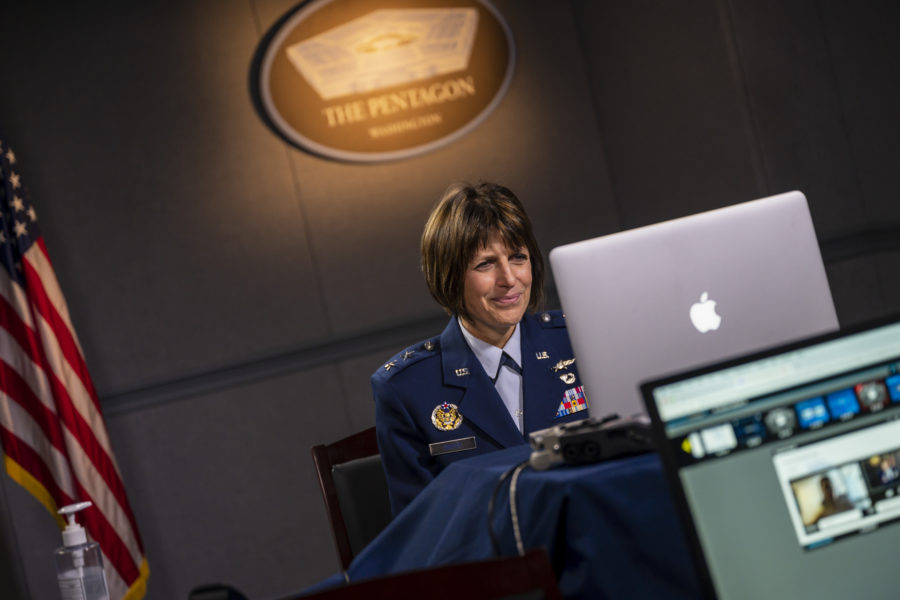The Department of the Air Force will set up a permanent office dedicated to digital engineering within Air Force Materiel Command that the Air Force and Space Force will share.
The department is “putting some resources and personnel in place to move from what has been a wonderful and fantastic campaign of a coalition of the willing, if you will, about 900-strong … to move to a more structured activity that can really be providing assistance and responsiveness and provisioning this journey,” said Kristin Baldwin, deputy assistant secretary of the Air Force for science, technology, and engineering.
An emphasis on digital engineering in its acquisition and research and development programs is part of the USSF’s vision, announced this month, to be a “digital service.”
Described simplistically, digital engineering leaves blueprints behind in favor of continuously evolving digital models. To provide an update on the department’s efforts to transition to digital engineering, Baldwin appeared on The Aerospace Corp.’s “The Space Policy Show” on May 13 along with Air Force Maj. Gen. Kimberly A. Crider, who is mobilization assistant to Chief of Space Operations Space Force Gen. John W. “Jay” Raymond.
Baldwin and Crider shared some of the lessons learned from pathfinder programs that are testing out processes, and they predicted some forthcoming changes, including what to expect in new and existing programs, trends in training and education, and the vision for a shared digital environment where all of the department’s future engineering development will take place.
Within the pathfinder programs, a common theme to emerge has been the importance of thinking ahead.
“We’re learning a lot about how the architecture needs to work, how you need to design for this up front, how you need to plan ahead to think through the kinds of architecture you require, the kinds of modeling that you need, the kinds of modeling tools and how to string these tools together in an open and modular kind of way,” Crider said.
It’s helped that the department had already introduced the “e” designation for programs that meet certain thresholds.
“As we’ve come along in the Space Force and looked to accelerate our efforts … we have found that having those capabilities available to us and starting from that instead of having to build all that out has saved us an immense amount of time,” Crider said.
Baldwin acknowledged that existing programs may not be able to incorporate many of the forthcoming changes, such as the common digital environment. An assessment will help determine what’s possible. New programs, meanwhile, are expected to go all in on digital engineering from the start.
Crider described how the shared engineering environment will work: “The government owning the development environment and the tech baseline that goes along with that and making that available to industry and programs throughout,” she said.
“We have become much more attuned to the importance and the value of common enterprise services and standards … this idea of common enterprise services that we want all programs to be able to leverage and use and industry partners to be able to leverage and use,” Crider said. “Many of you out there have heard about Cloud One and the government’s program to deliver enterprise cloud services leveraging commercial industry products and toolsets and integrating that into a set of services that are secure. …”
Eventually the environment will include more components, including Platform One, Crider said:
“Platform One deployed on Cloud One—to provide that environment, that tech stack—for continuous development of models, integration of models, and then infusion of data associated with those models. And that data is brought in from Data One—so a common enterprise set of services for hosting, storing, managing, securing, and protecting data.”
The digital vision won’t come to pass without a more skilled workforce, Crider said. While she’s noticed that higher ed institutions are teaching digital engineering more often, the department has another plan—namely, Digital University—to offer content with which members can continuously build on digital skills.
They cited data security and interoperability of the shared environment as challenges going forward, but those may not be the biggest.
“It’s one thing to build out the environment,” Crider said. “It’s another thing to actually make it part of how you work. So the whole cultural evolution, really getting in the pool and doing your program review, your test reviews, your capability development—all in this rapid, integrated fashion, where all day, every day, we can do a program design review with our partners right on the fly, and we can dive deep on different design options and think through things with our partners across industry …
“Actually shifting our culture … that can’t be understated.”
